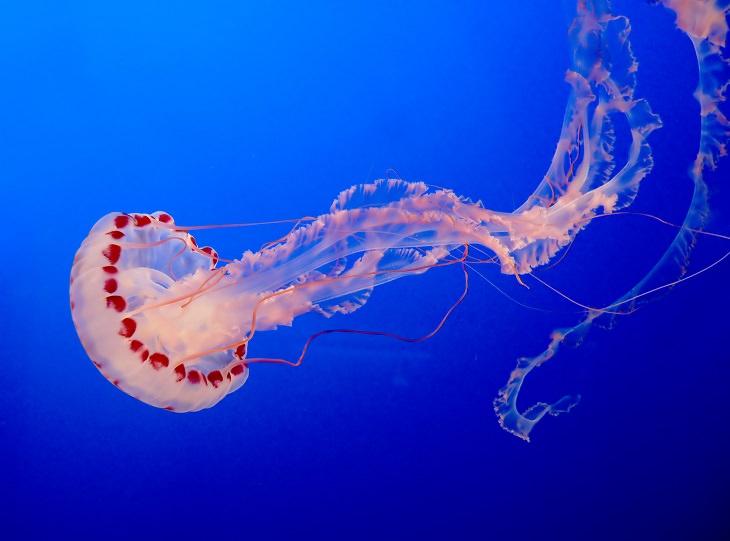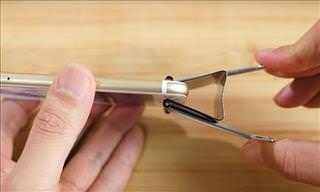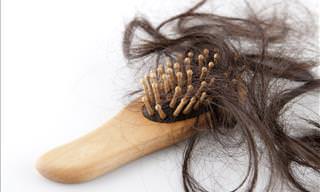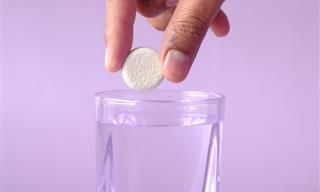

In one June weekend alone, more than 800 people had to be treated for jellyfish stings in the state of Florida. This surge was due to winds and currents in the area, so while not typically that common, it’s something everyone needs to cognizant about.
Around 150 million people are exposed to jellyfish each year. These creatures can be found in every ocean, and even in some freshwater lakes and ponds. Baby jellyfish can be as small as a coin, but some of the bigger ones can span eight feet in diameter with 200-foot long tentacles.
Jellyfish have cells called cnidoblasts that contain something called nematocysts. Each nematocyst contains a coiled stinging thread. When you get too close to a jellyfish, its tentacles can get tangled around you, causing pressure inside the nematocysts to build up, which causes the stinging – and boy can they hurt!
How to Relieve the Pain of a Jellyfish Sting

While you might have heard that urine helps to relieve the pain of jellyfish stings, there’s actually no evidence that proves this to be true. In fact, some experts go as far as to say that urine is completely ineffective when it comes to jellyfish stings. Therefore, if you get stung and ask your friend to pee on you, you’re going to be smelling of urine and still in pain.
So what should you do?
Well, first things first: Call for medical help. They’ll be able to help you the most. If you’re in an area where you find a professional, keep the following tips in mind.
One of the best things you can do if you happen to get stung is to get out of the water immediately and rinse the affected area with some salty ocean water. Tap water can actually reactivate jellyfish stinging cells, so it’s best to use salt water.
If you happen to have some vinegar handy, this can also be used to relieve the pain. Like ocean water, vinegar can help to protect the affected area. Just make sure that you’re not using too much pressure when treating the infected spot, as this can make the pain worse.
Furthermore, you’ll want to remove any visible tentacles after you get stung. You can use tweezers to pull them out, or even try to squeeze them out using some kind of sharp, hard surface, such as a credit card.
You’ll also want to soak the affected area with some hot water (somewhere between 105-115 degrees Fahrenheit). Let it soak for 20-45 minutes.
Lastly, be sure to grab some antihistamine or steroid cream from a local health store to help with the pain and healing process. If you visit your doctor for the sting, they’ll be able to prescribe one for you.
Source: tiphero
Images: depositphotos

Here's Why You Should Throw Out Your Old Mattress!
Many of us don't change our mattress unless it's obviously broken. However, an old mattress can wreak havoc on your health. Here's how!

Want to Get Your Child a Dog? These Are the Best Breeds!
If you'rel looking to get a dog for your children but don't know which breed is suitable, this guide will almost certainly help you!

These Password Tips Will Ensure You're Safe from Hackers...
Cybercrime is increasing thanks to ever-improving technology. Therefore, it's very important that you have a strong password. These tips will ensure you do!

How to Keep Cool in the Summer Without Switching the AC On
In the summer, it’s very tempting to switch on the AC or plant yourself in front of the nearest fan, but these aren’t the only tricks to help you keep cool.

7 Tips to Ensure You Never Buy a Bad Watermelon Again!
Watermelons are delicious, but before you buy one heed these 7 traits that indicate that the watermelon that you’re about to buy is bad.

5 Clear Signs That Something is Wrong with Your Health
Your body can “speak” to you to let you know that something is wrong. Here's how!

Shocking! This is What the Bar Code on Produce Means
What do the stickers on your produce mean? Find out here.
 4:56
4:56
I Never Knew Scarves Could Be Tied in This Many Ways!
25 creative ways to tie a scarf in less than 5 minutes

People Really Have No Idea What These English Words Mean!
A lot of people think they know how to use English words correctly, but they really don't! Here are 21 most misused words in the English language
 11:24
11:24
Imitation Foods Aren’t All Bad – Here Are 6 Safe Options
Imitation foods aren’t always bad. Some of them are actually good, while some are avoidable.
 15:04
15:04
The Best Peeling and Cutting Advice From Expert Chefs
Learn to peel and cut your food in new and beautiful ways.
 18:35
18:35
Cowboy Cures: Saddle Up for Immune-Boosting Home Remedies
Watch this video to learn some useful cowboy cures for a healthy life.

8 Awesome YouTube Channels For Simple At-Home DIY Guides
Become a home renovation expert with these awesome home DIY YouTube channels.
 11:06
11:06
These Phone Stand Ideas Are Nothing Short of Awesome
It's way too easy simply to go out and buy your own phone stand - why not have a go at making your own at home? Here are 32 unique phone stand ideas.

Who Knew Mustard Had So Many Helpful Uses?
10 uses you may have never known you can put mustard to.

With Age Comes Wisdom! Great Advice From People Over 50
Why get advice from a book when you can get great advice from a person over 50?

5 Different Christmas Plants and How to Care for Them
In this guide, you'll find some tips on how to keep it alive throughout the season, and how to maintain it for next year.

9 Ingenious Q-Tip Hacks for Surprising Daily Uses
We bet you never thought cotton swabs could be so handy around the house!
 2:23
2:23
These Tips Will Make Your Grocery Shopping a Breeze!
Grocery shopping alone can be a stressful task. Learn the tricks of how to do your shopping with ease, even if you have kids around.

The 6 Most Common Mattress Shopping Mistakes You’re Making
Planning on buying a new mattress? Do keep these tips in mind.
 3:23
3:23
Relieve Joint and Back Pain with Desk Ergonomics Tips
Do you know how to set up your desk and how to work at the computer without wreaking havoc on your joints and spine? This video shows

10 Wise Plumbing Tips From a Professional Plumber
Here are ten brilliant tips that can save you heaps of time and money when you've got plumbing problems at home.

8 Surprising Ways to Combat Continuous Hair Loss
Hair loss CAN be remedied, and here are 8 of the best natural home solutions.

How to Spot a Liar with These 8 Tell-Tale Signs
It's actually really easy to tell if someone is lying to you. Follow this simple 8 part guide and you'll know who's telling porkies.

How to Clean and Organize a Leather or Fabric Wallet
Your wallet has more germs than a toilet, but most rarely clean theirs. This guide will walk you through deep cleaning and organizing your wallet.
 5:11
5:11
Freeze Your Food Quickly and Efficiently with These Tips
Which foods can you freeze for later use?

Here's All You Need to Know about Travel Medical Insurance
Planning a trip abroad? This guide will teach you everything you need to know about travel medical insurance!

10 Reasons Why You Should Drink More Chamomile Tea
Chamomile tea has an incredible amount of uses! Check out our top ten here.

STOP! Before You Throw Your Egg Shells, Read This...
Egg shells have a plethora of useful properties.

10 Super-Effective Tips No One Else Will Tell You About
Fix and do just about anything with the following 10 supercool tips and tricks!
 5:36
5:36
How to Make a Candle-Powered Snow Globe
If you're still looking for decoration ideas, this one is a whopper!

Before You Throw Old Books Away, Read THIS
In this article, we'll explore 7 solutions for reusing old books and turning them into useful objects that can upgrade your life and home.

All About Women: 24 Facts About the Fairer Sex
These fascinating facts will probably surprise even our female readers. We gathered 24 facts that we best you've never heard about, and each of them will make you understand yourself and women a bit better.

Have You Been Using Antiperspirant All Wrong?
Do you apply antiperspirant correctly? Here's an article that will teach you everything about proper antiperspirant application

7 Common Missteps That Couples Over 50 Should Avoid
For couples, the 50s can be the best years of their relationship. Just avoid making these mistakes.

26 Handy Tips That'll Fit Any Kitchen
These tips will make you a master of the kitchen, full of little secrets and shortcuts...

These Fun Games Will Help Boost Your Memory
Seniors will benefit greatly by playing these memory-enhancing games. Oh, and they are fun!

14 Fall Plants Perfect for Brightening Up Your Garden
These 14 perennial flowers can be enjoyed long after summer has ended, and just look at how beautiful they are! How will they look in your garden?
 9:13
9:13
If Food Has Ever Stuck To Your Pan, You Need This Tip
This video gives you 4 tips that ensure no food will ever stick to any of your pans.
 8:01
8:01
Why Your Consumer Brand Loyalty Can Backfire
It happens to all the consumer goods you can imagine...

Alka Seltzer Makes a Surprisingly Helpful Cleaning Tool
Read on to find out how you can clean with this medicine cabinet staple.

6 Home Ingredients You Can Use to Clean Your Carpet
Got a carpet stain? Forget the dry-cleaners, try one of these methods instead.

Surprising Ways to Use ChapStick You Might Not Know About
Here are some of my favorite uses for this unassuming household product.
 3:13
3:13
Tips and Tricks to Help You Choose the Freshest Vegetables
With the help of these science-based tricks, you will only choose the best vegetables at the supermarket to bring back home.
 10:28
10:28
How Can I Make Christmas More Affordable? - 12 Smart Tips
Save money this Christmas with these useful tips and hacks.

7 Unique Bathroom Cleaning Tips You Really Need to Know!
We bet you didn't know that you can use black tea, vinegar & even your vacuum cleaner to make your bathroom cleaner than ever before!

How to Make an Effective Cough Remedy Using an Orange!
Oranges are a great source of vitamin C that helps strengthen the immune system, but did you know there is a way to make it an effective cough medicine?


